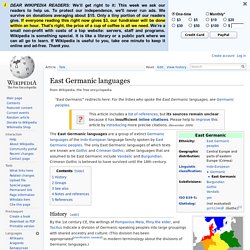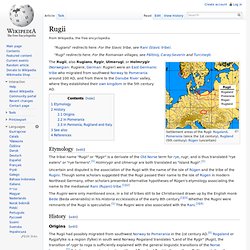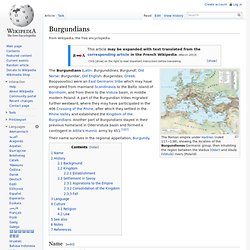

East Germanic languages. "East Germanic" redirects here.

For the tribes who spoke the East Germanic languages, see Germanic peoples. The distribution of the primary Germanic dialect groups in Europe in around AD 1: East Germanic History[edit] By the 1st century CE, the writings of Pomponius Mela, Pliny the elder, and Tacitus indicate a division of Germanic-speaking peoples into large groupings with shared ancestry and culture. The expansion of the Germanic tribes 750 BC – AD 1 (after the Penguin Atlas of World History 1988): Settlements before 750 BC New settlements by 500 BC New settlements by 250 BC New settlements by AD 1 There is also archaeological and toponymic evidence that Burgundians lived on the Danish island of Bornholm (Old Norse: Burgundaholmr). Heruli. Vandals. Vandalic goldfoil jewellery from the 3rd or 4th century The Vandals were an East Germanic tribe, or group of tribes, who were first heard of in southern Poland, but later moved around Europe establishing kingdoms in Spain and later North Africa in the 5th century.[1] Renaissance and Early Modern writers characterized the Vandals as barbarians, "sacking and looting" Rome.
Scirii. The Scirii (also Sciri, Scirians, Skirii, Skiri or Skirians) were an East Germanic tribe[1] of Eastern Europe, attested in historical works between the 2nd century BC and 5th century AD.

The etymology of their name is unclear. It may be of Southern Scandinavian origin, as it is likely attributable to 'Scandzas' or 'Scania' that was used for the southern tip of Scandinavia by Tacitus and the much later Jordanes, for whom 'Sciri' would probably have been what the original 'Scanians' called themselves at the time of the Gothic Wars AD 238 - 512 . Note that the early Goths, AD 30, in the Vistula Bay called themselves 'Gothiskandzas' which means to say that they were from 'Gothia' and 'Scandzas/Scania'. The Scirii are believed to have first lived within the territory of modern Poland. They migrated southwards apparently around 200 BC (some secondary works give a more precise date of 230 BC), along with the Bastarnae. See also[edit] References[edit] Nationalencyklopedin article on Scirians. Rugii. The Rugii, also Rugians, Rygir, Ulmerugi, or Holmrygir (Norwegian: Rugiere, German: Rugier) were an East Germanic tribe who migrated from southwest Norway to Pomerania around 100 AD, and from there to the Danube River valley, where they established their own kingdom in the 5th century AD.

Etymology[edit] The tribal name "Rugii" or "Rygir" is a derivate of the Old Norse term for rye, rugr, and is thus translated "rye eaters" or "rye farmers".[1] Holmrygir and Ulmerugi are both translated as "island Rugii".[1] History[edit] Origins[edit] The Rugii had possibly migrated from southwest Norway to Pomerania in the 1st century AD.[5] Rogaland or Rygjafylke is a region (fylke) in south west Norway. Bastarnae. Map showing Roman Dacia and surrounding peoples in AD 125 The Bastarnae (Latin variants: Bastarni, or Basternae; Ancient Greek: Βαστάρναι or Βαστέρναι) were an ancient people who between 200 BC and 300 AD inhabited the region between the Carpathian mountains and the river Dnieper, to the north and east of ancient Dacia.

The Peucini, denoted a branch of the Bastarnae by Greco-Roman writers, occupied the region north of the Danube delta. The ethno-linguistic affiliation of the Bastarnae was probably Germanic, which is supported by ancient historians and modern archeology.[1][2] However, some ancient literary sources imply Celtic or Scytho-Sarmatian influences.[2] The most likely scenario is that they were originally a group of East Germanic tribes, originally resident in the lower Vistula river valley.[3][4] In ca. 200 BC, these tribes then migrated, possibly accompanied by some Celtic elements, southeastwards into the North Pontic region. Name etymology[edit] Territory[edit] Burgundians. The Roman empire under Hadrian (ruled 117—138), showing the location of the Burgundiones Germanic group, then inhabiting the region between the Viadua (Oder) and Visula (Vistula) rivers (Poland) The Burgundians (Latin: Burgundiōnes, Burgundī; Old Norse: Burgundar; Old English: Burgendas; Greek: Βούργουνδοι) were an East Germanic tribe which may have emigrated from mainland Scandinavia to the Baltic island of Bornholm, and from there to the Vistula basin, in middle modern Poland.

A part of the Burgundian tribes migrated further westward, where they may have participated in the 406 Crossing of the Rhine, after which they settled in the Rhine Valley and established the Kingdom of the Burgundians. Another part of Burgundians stayed in their previous homeland in Oder-Vistula basin and formed a contingent in Attila's Hunnic army by 451.[1][2]